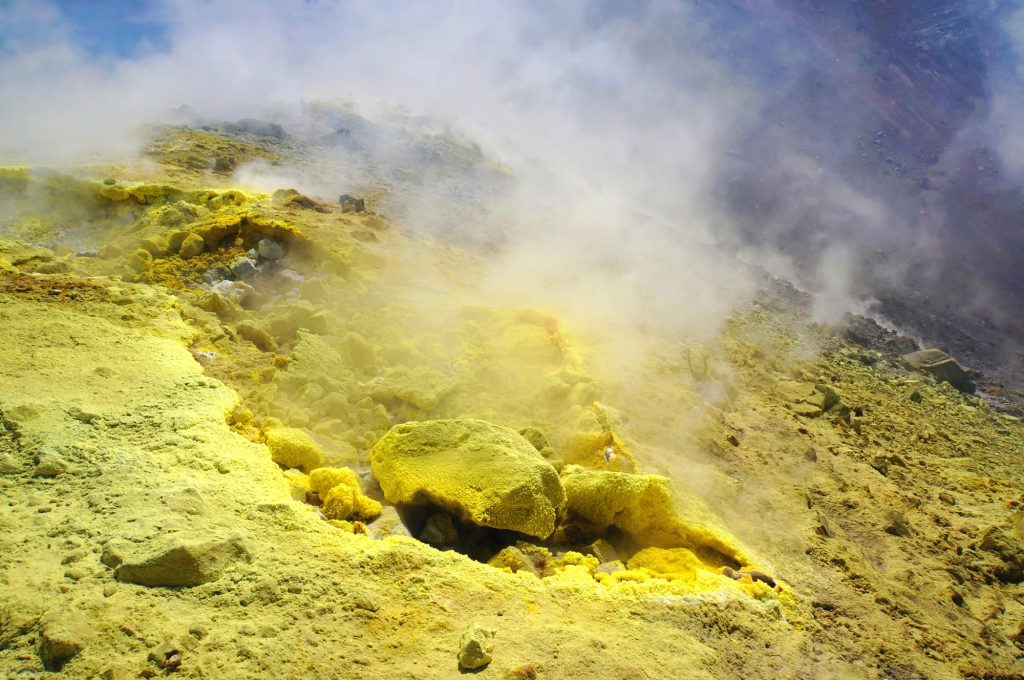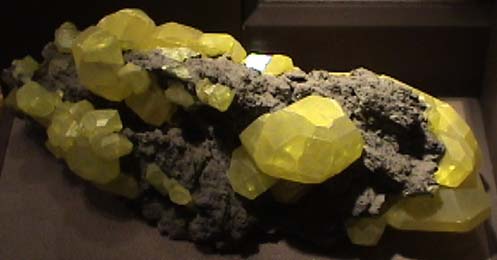Sulphur or Sulfur?
Sulfur is an alternative American form of the English word Sulphur. The American spelling of Sulfur was introduced by Noah Webster when he published his American Dictionary of the English Language in 1828. Noah Webster advocated spelling reform by removing unnecessary letters from words.
In 1990 IUPAC adopted the spelling sulfur, as did the Royal Society of Chemistry Nomenclature Committee in 1992. The Oxford Dictionary notes that “In chemistry… the -f- spelling is now the standard form in all related words in the field in both British and US contexts”.
What is Sulfur as on the Periodic Table? Definition of the Sulfur Element – British spelling Sulphur
Sulfur is a solid. It is a pale yellow non-metallic, brittle, element occurring widely in nature in several free and combined allotropic forms. Sulphur is infamous for its highly unpleasant smell. Although solid sulfur is bright yellow, molten sulfur is bright red. It is used in black gunpowder, rubber vulcanization, the manufacture of insecticides and pharmaceuticals, and in the preparation of sulfur compounds such as Hydrogen sulfide and sulfuric acid. The Atomic Number of this element is 16 and the Element Symbol is S.
What is Sulfur? Origin / Meaning of the name Sulfur – British spelling Sulphur
The name originates from the Latin word ‘sulphurium’ and Middle English ‘sulfre’ or ‘swefl’ meaning “to burn yellow”. The ancient Latin name was a derivation of the Sanskit word ‘Sulvere’ meaning yellow. The ancient name for sulfur is Brimstone, which derives from the Old English word brynstan, from ‘brin’ meaning “to burn” and ‘stan’ meaning “stone.”. Both the words Sulfur and Brimstone therefore translate to mean “to burn”. The word Brimstone is now restricted to biblical usage.
What is Sulfur? Periodic Table Group and Classification of the Sulfur Element – British spelling Sulphur
Elements can be classified based on their physical states (States of Matter) e.g. gas, solid or liquid. This element is a solid. Sulfur is classified as an element in the ‘non-metals’ section which can be located in groups 14,15 and 16 of the Periodic Table. Non-metallic elements exist, at room temperature, in two of the three states of matter: gases (Oxygen, Hydrogen & Nitrogen) and solids (Carbon, Phosphorus, Sulfur and Selenium). For additional facts and information refer to Sulfur Properties.
What is Sulfur? Facts about the Discovery and History of the Sulfur Element
The discovery of Sulfur dates back to Antiquity and used by the ancient South Americans, Asians, Egyptians, Greeks, Romans and Chinese. Sulfur was first discovered by the Ancient civilisations. It was often used in their religious rites as the odor of burning sulfur was believed to ward off evil spirits. The ancient Romans used sulfur in pyrotechnic displays in the Roman Colosseum and also in the production of incendiary weapons including Greek Fire. In 1787 Antoine Lavoisier listed Sulfur as an element, and not a compound In 1867, sulfur was discovered in underground deposits in Louisiana and Texas. Sulfur is produced chiefly by the Frasch process for the extraction of sulfur from subsurface deposits. It was devised by German-American chemist Herman Frasch in 1887.
Herman Frasch (1851-1914)
What is Sulfur? Occurrence of the Sulfur Element
Exists as molecules in the solid state. The element sulphur has been known from the earliest times, since it is widely distributed in nature and occurs in large quantities in the uncombined form, especially in the neighborhood of volcanoes. Sicily has long been famous for its sulphur mines, and smaller deposits are found in Italy, Iceland, Mexico, and especially in Louisiana, where it is mined extensively. In combination, sulphur occurs abundantly in the form of sulphides and sulphates. In smaller amounts it is found in a great variety of minerals, and it is a constituent of many animal and vegetable substances.
Abundances of Sulfur
% in Universe 0.05%
% in Sun 0.04%
% in Meteorites 4%
% in Earth’s Crust 0.042%
% in Oceans 0.093%
% in Humans 0.2%
Associated Uses of Sulfur – British spelling Sulphur
Insecticides
Pharmaceuticals
Matches
Gunpowder
Fireworks
Production of sulfuric acid
Batteries
Detergents
Sulphur dioxide


